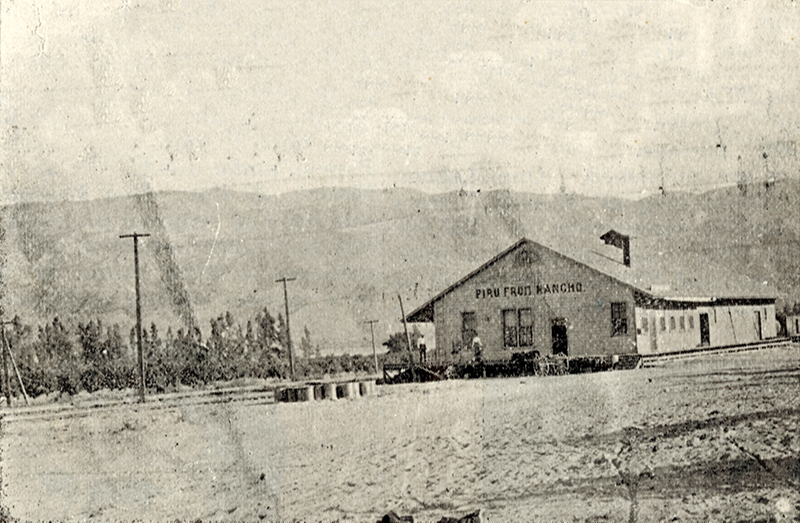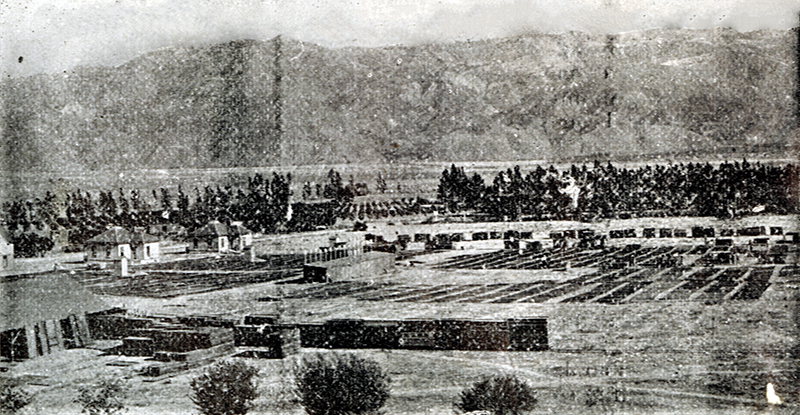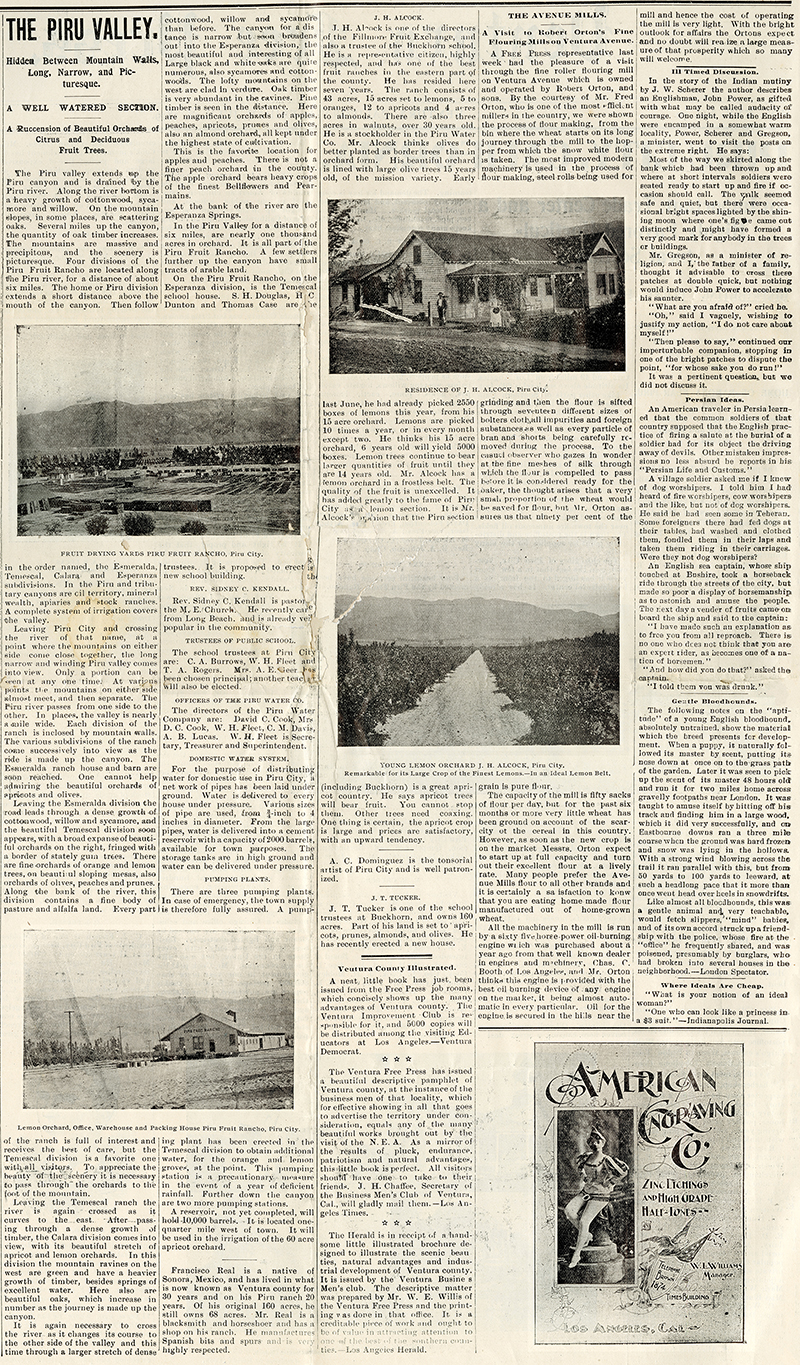A Well Watered Section.
A Ruccension of Beautiful Orchards of Citrus and Deciduous Fruit Trees.

Click to enlarge.
|
The Piru valley extends up the Piru canyon and is drained by the Piru river. Along the river bottom is a heavy growth of cottonwood, sycamore and willow. On the mountain slopes, in some places, are scattering oaks. Several miles up the canyon, the quantity of oak timber increases. The mountains are massive and precipitous, and the scenery is picturesque. Four divisions of the Piru Fruit Rancho are located along the Piru river, for a distance of about six miles. The home or Piru division extends a short distance above the mouth of the canyon. Then follow in the order named, the Esmeralda, Temescal, Calara and Esperanza subdivisions. In the Piru and tributary canyons are oil territory, mineral wealth, apiaries and stock ranches. A complete system of irrigation covers the valley.
Leaving Piru City and crossing the river of that name, at a point where the mountains on either side come close together, the long, narrow and winding Piru valley comes into view. Only a portion can be seen at any one time. At various points the mountains on either side almost meet, and then separate. The Piru river passes from one side to the other. In places, the valley is nearly a mile wide. Each division of the ranch is inclosed by mountain walls. The various subdivisions of the ranch come successively into view as the ride is made up the canyon. The Esmeralda ranch house and barn are soon reached. One cannot help admiring the beautiful orchards of apricots and olives.
Leaving the Esmeralda division, the road leads through a dense growth of cottonwood, willow and sycamore, and the beautiful Temescal division soon appears, with a broad expanse of beautiful orchards on the right, fringed with a border of stately gum trees. There are fine orchards of orange and lemon trees, on beautiful sloping mesas, also orchards of olives, peaches and prunes. Along the bank of the river, this division contains a fine body of pasture and alfalfa land. Every part of the ranch is full of interest and receives the best of care, but the Temescal division is a favorite one with all visitors. To appreciate the beauty of the scenery it is necessary to pass through the orchards to the foot of the mountain.

Click to enlarge.
Leaving the Temescal ranch the river is again crossed as it curves to the east. After passing through a dense growth of timber, the Calara division conies into view, with its beautiful stretch of apricot and lemon orchards. In this division the mountain ravines on the west are green and have a heavier growth of timber, besides springs of excellent water. Here also are beautiful oaks, which increase in number as the journey is made up the canyon.
It is again necessary to cross the river as it changes its course to the other side of the valley and this time through a larger stretch of dense cottonwood, willow and sycamore than before. The canyon for a distance is narrow but soon broadens out into the Esperanza division, the most beautiful and interesting of all. Large black and white oaks are quite numerous, also sycamores and cottonwoods. The lofty mountains on the west are clad in verdure. Oak timber is very abundant in the ravines. Pine timber is seen in the distance. Here are magnificent orchards of apples, peaches, apricots, primes and olives, also an almond orchard, all kept under the highest state of cultivation.
This is the favorite location for apples and peaches. There is not a finer peach orchard in the county. The apple orchard bears heavy crops of the finest Bellflowers and Pearmains.
At the bank of the river are the Esperanza Springs.
In the Piru Valley for a distance of six miles, are nearly one thousand acres in orchard. It is all part of the Piru Fruit Rancho. A few settlers further up the canyon have small tracts of arable land.
On the Piru Fruit Rancho, on the Esperanza division, is the Temescal school house. S.H. Douglas, H.C. Dunton and Thomas Case are the trustees. It is proposed to erect a new school building.
Rev. Sindey C. Kendall.
Rev. Sidney C. Kendall is pastor of the M.E. Church. He recently came from Long Beach, and is already very popular in the community.
Trustees of Public School.
The school trustees at Piru City are: C.A. Burrows, W.H. Fleet and T.A. Rogers. Mrs. A.E. Geer has been chosen principal; another teacher will also be elected.
Officers of the Piru Water Co.
The directors of the Piru Water Company are: David C. Cook, Mrs. D.C. Cook, W.H. Fleet, C.M. Davis, A.B. Lucas. W.H. Fleet is Secretary, Treasurer and Superintendent.
Domestic Water System.
For the purpose of distributing water for domestic use in Piru City, a network of pipes has been laid under ground. Water is delivered to every house under pressure. Various sizes of pipe are used, from ¾-inch to 4 inches in diameter. From the large pipes, water is delivered into a cement reservoir with a capacity of 2,000 barrels, available for town purposes. The storage tanks are in high ground and water can be delivered under pressure.
Pumping Plants.
There are three pumping plants. In case of emergency, the town supply is therefore fully assured. A pumping plant has been erected in the Temescal division to obtain additional water, for the orange and lemon groves, at the point. This pumping station is a precautionary measure in the event of a year of deficient rainfall. Further down the canyon are two more pumping stations.
A reservoir, not yet completed, will hold 10,000 barrels. It is located one-quarter mile west of town. It will be used in the irrigation of the 60 acre apricot orchard.
Francisco Real is a native of Sonora, Mexico, and has lived in what is now known as Ventura county for 30 years and on his Piru ranch 20 years. Of his original 160 acres, he still owns 68 acres. Mr. Real is a blacksmith and horseshoer and has a shop on his ranch. He manufactures Spanish bits and spurs and is very highly respected.
J.H. Alcock.
J.H. Alcock is one of the directors of the Fillmore Fruit Exchange, and also a trustee of the Buckhorn school. He is a representative citizen, highly respected, and has one of the best fruit ranches in the eastern part of the county. He has resided here seven years. The ranch consists of 43 acres, 15 acres set to lemons, 5 to oranges, 12 to apricots and 4 acres to almonds. There are also three acres in walnuts, over 30 years old. He is a stockholder in the Piru Water Co. Mr. Alcock thinks olives do better planted as border trees than in orchard form. His beautiful orchard is lined with large olive trees 15 years old, of the mission variety. Early last June, he had already picked 2,550 boxes of lemons this year, from his 15 acre orchard. Lemons are picked 10 times a year, or in every month except two. He thinks his 15 acre orchard, 6 years old will yield 5,000 boxes. Lemon trees continue to bear larger quantities of fruit until they are 14 years old. Mr. Alcock has a lemon orchard in a frostless belt. The quality of the fruit is unexcelled. It has added greatly to the fame of Piru City as a lemon section. It is Mr. Alcock's opinion that the Piru section (including Buckhorn) is a great apricot country. He says apricot trees will bear fruit. You cannot stop them. Other trees need coaxing. One thing is certain, the apricot crop is large and prices are satisfactory, with an upward tendency.
A.C. Dominguez is the tonsorial artist of Piru City and is well patronized.
J.T. Tucker.
J.T. Tucker is one of the school trustees at Buckhorn, and owns 160 acres. Part of his land is set to apricots, prunes, almonds, and olives. He has recently erected a new house.
Ventura County Illustrated.
A neat little book has just been issued from the Free Press job rooms, which concisely shows up the many advantages of Ventura county. The Ventura Improvement Club is responsible for it, and 5,000 copies will be distributed among the visiting Educators at Los Angeles. — Ventura Democrat.
The Ventura Free Press has issued a beautiful descriptive pamphlet of Ventura county, at the instance of the business men of that locality, which for effective showing in all that goes to advertise the territory under consideration, equals any of the many beautiful works brought out by the visit of the N.E.A. [Newspaper Enterprise Association, a syndicate — Ed.]. As a mirror of the results of pluck, endurance, patriotism and natural advantages, this little book is perfect. All visitors should have one to take to their friends. J.H. Chaffee, Secretary of the Business Men's Club of Ventura, Cal., will gladly mail them. — Los Angeles Times.
The Herald is in receipt of a handsome little illustrated brochure designed to illustrate the scenic beauties, natural advantages and industrial development of Ventura county. It is issued by the Ventura Business Men's club. The descriptive matter was prepared by Mr. W.E. Willis of the Ventura Free Press and the printing was done in that office. It is a creditable piece of work and ought to be of value in attracting attention to one of the best of the southern counties. — Los Angeies Herald.
The Avenue Mills.
A Visit to Robert Orton's Fine Flouring Mills on Ventura Avenue.
A Free Press representative last week had the pleasure of a visit through the fine roller flouring mill on Ventura Avenue which is owned and operated by Robert Orton, and sons. By the courtesy of Mr. Fred Orton, who is one of the most efficient millers in the country, we were shown the process of flour making, from the bin where the wheat starts on its long journey through the mill to the hopper from which the snow white flour is taken. The most improved modern machinery is used in the process of flour making, steel rolls being used for grinding and then the flour is sifted through seventeen different sizes or bolters cloth, all impurities and foreign substances as well as every particle of bran and shorts being carefully removed during the process. To the casual observer who gazes in wonder at the fine meshes of silk through which the flour is compelled to pass before it is considered ready for the oaker, the thought arises that a very small proportion of the wheat would be saved for flour, but Mr. Orton assures us that ninety per cent of the grain is pure flour.
The capacity of the mill is fifty sacks of flour per day, but for the past six months or more very little wheat has been ground on account of the scarcity of the cereal in this country. However, as soon as the new crop is on the market, Messrs. Orton expect to start up at full capacity and turn out their excellent flour at a lively rate. Many people prefer the Avenue Mills flour to all other brands and it is certainly a satisfaction to know that you are eating home made flour manufactured out of home-grown wheat.
All the machinery in the mill is run by a sixty five horse-power oil-burning engine which was purchased about a year ago from that well known dealer in engines and machinery, Chas. C. Booth of Los Angeles, and Mr. Orton thinks this engine is provided with the best oil burning device of any engine on the market, it being almost automatic in every particular. Oil for the engine is secured in the hills near the mill and hence the cost of operating the mill is very light. With the bright outlook for affairs the Ortons expect and no doubt will realize a large measure of that prosperity which so many will welcome.
Ill Timed Discussion.
In the story of the Indian mutiny by J.W. Scherer the author describes an Englishman, John Power, as gifted with what may be called audacity of courage. One night, while the English were encamped in a somewhat warm locality, Power, Scherer and Gregson, a minister, went to visit the posts on the extreme right. He says:
Most of the way we skirted along the bank which had been thrown up and where at short intervals soldiers were seated ready to start up and fire if occasion should call. The walk seemed safe and quiet, but there were occasional bright spaces lighted by the shining moon where one's figure came out distinctly and might have formed a very good mark for anybody in the trees or buildings.
Mr. Gregson, as a minister of religion, and the father of a family, thought it advisable to cross these patches at double quick, but nothing would induce John Power to accelerate his saunter.
"What are you afraid of?" cried he. "Oh," said I vaguely, wishing to justify my action, "I do not care about myself!"
"Then please to say," continued our imperturbable companion, stopping in one of the bright patches to dispute the point, "for whose sake you do run!"
It was a pertinent question, but we did not discuss it.

Click to enlarge.












